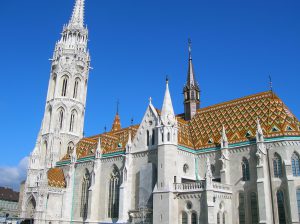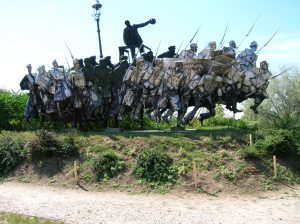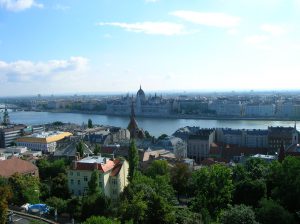Budapest
By Tracy A. Burns
Savor the view of the gently flowing Danube with Buda Castle and the elaborate spire of Matthias Church in the background. Take a stroll down the picturesque pedestrian streets in Pest. Improve your knowledge of Hungarian history by visiting Matthias Church, the Hungarian National Museum, The House of Terror, and Memento Park. Appreciate the remarkable art works in the Hungarian National Gallery and the Fine Arts Museum. Take a tour of the Opera House and Parliament with their enthralling exteriors and interiors. These are just some of the sightseeing possibilities in romantic and magical Budapest.
The Opera House
Opening its doors during the fall of 1884 with Austro-Hungarian Emperor Franz Joseph I in attendance, the Budapest Opera House is a spectacular example of Neo-Renaissance architecture. The exterior is dominated by superb statuary, including statues of composers Franz Liszt, Ludwig van Beethoven, Wolfgang Amadeus Mozart, and Bedřich Smetana. Allegorical figures of music make appearances as well.
While the main foyer’s marble columns and black-and-white floor mosaic astound, the many ceiling and wall murals depicting mythological figures such as Apollo and Dionysus are what deserves the most attention. The highlight of the tour is the auditorium’s circular ceiling mural “The Apotheosis of Music” by Kárloy Lotz. It is set on Mount Olympus, where Apollo is giving a lute concert on a golden-pink cloud under a blue sky. Dionysus is present, and his followers carry tambourines and cymbals. Eros is flying, a putto holds a mirror for Aphrodite, Zeus is perched on his throne, winged Niké bellows out a song, Hades is abducting Persephone, and snakes sliver around the Furies. The side foyers, the Royal Reception Room, the grand staircase, and other places will also leave you gasping in awe.
The Parliament
The Neo-Gothic Parliament set on the Danube embankment also offers tours of its astounding interior. The largest building in the country, this architectural gem was constructed from 1884 to 1902. The Neo-Renaissance dome delights, the main staircase boasts ceiling frescoes and statues, and the Hungarian crown is on display. Those are just a few of the highlights of this prominent structure that is 268 meters long and 96 meters high with 691 rooms.
Matthias Church and Saint Stephen´s Basilica
 To learn more about Hungarian history, visit the Gothic Matthias Church near Buda Castle. Built between the 13th and 15th centuries, Matthias Church amazes with its ceiling and wall paintings that portray scenes from the country’s past. The painting of the coat-of-arms of King Matthias is gigantic. Do not overlook the stained glass windows, the pulpit, and altarpieces. The tomb of King Béla III can be viewed from behind a barred grating. It is one of the two tombs of Hungarian kings that are around today as the Ottomans demolished the others. Another religious site is Saint Stephen’s Basilica, where the fist of King Stephen, the first Catholic king of Hungary, rests in a reliquary. Elaborate statuary and paintings also adorn the holy place. A Black Madonna painting can also be viewed.
To learn more about Hungarian history, visit the Gothic Matthias Church near Buda Castle. Built between the 13th and 15th centuries, Matthias Church amazes with its ceiling and wall paintings that portray scenes from the country’s past. The painting of the coat-of-arms of King Matthias is gigantic. Do not overlook the stained glass windows, the pulpit, and altarpieces. The tomb of King Béla III can be viewed from behind a barred grating. It is one of the two tombs of Hungarian kings that are around today as the Ottomans demolished the others. Another religious site is Saint Stephen’s Basilica, where the fist of King Stephen, the first Catholic king of Hungary, rests in a reliquary. Elaborate statuary and paintings also adorn the holy place. A Black Madonna painting can also be viewed.
The Hungarian National Museum
The Hungarian National Museum offers the visitor a lesson in Hungarian history from the beginning of time to the 1989 Revolution. An extensive collection of tombstones and statues in the cellar is sure to impress as are the Gothic well and the Renaissance choir stalls with ornate, detailed woodwork. The 20th-century exhibition that explores the eras of Nazism and Communism is very enlightening, giving the visitor a feel for life during those terrible times.
The House of Terror
Another museum that gives the visitor a feel for life under Nazism and Communism is the House of Terror on 60 Andrássy Boulevard, where the Nazi Arrow Cross Party, which functioned as a sort of Hungarian Gestapo and was a creature of the ultra-nationalist and anti-capitalist Szálasi, and later the Communist secret police had their headquarters. It was here that thousands of citizens were interrogated, beaten, and even murdered. Torture and intimidation were no strangers to this place. Intriguing from an architectural standpoint as well as for its content, the House of Terror confronts visitors with a Soviet T-54 tank in its atrium. Tanks like these crushed the 1956 Revolution, when Hungarians protested against the regime, longing to live in a free and independent country. In an exhibition space dedicated to Hungarians who had become Nazis, the setting is a long table with Arrow Cross china. The prominent V on the plates is a Nazi symbol that stands for victory. An Arrow Cross uniform occupies the head of the table, making it even more spooky. The gulag exhibition is particularly stunning with its huge carpet of a map of the USSR highlighted with the locations of the work camps. Former prisoners who slaved away in the camps describe their experiences, giving a poignant resonance to the room’s display. Also, on video screens trains speed through a wintry landscape. In a space focusing on the 1956 Hungarian uprising, a Hungarian flag is missing its Soviet symbol in the center. The Changing Clothes exhibition involves a video of guards changing from Arrow Cross uniforms to Communist dress. Torture machines are also on display. The photos of more than 3,000 people who died in this very building stare, haunting the viewer.
Memento Park
 Memento Park gives the tourist another taste of Communist ideology and propaganda as it features statues from totalitarian times. Statues of Vladimír Lenin, Karl Marx, and Friedrich Engels greet the visitor at the entrance. An expressionless huge soldier grips a Soviet flag. Lenin holds up one arm in a stiff salute. A Communist worker leaps forward, proudly displaying a Soviet flag.
Memento Park gives the tourist another taste of Communist ideology and propaganda as it features statues from totalitarian times. Statues of Vladimír Lenin, Karl Marx, and Friedrich Engels greet the visitor at the entrance. An expressionless huge soldier grips a Soviet flag. Lenin holds up one arm in a stiff salute. A Communist worker leaps forward, proudly displaying a Soviet flag.
The Hungarian National Gallery
Artwork is a must-see on any tourist’s itinerary in Budapest. The Hungarian National Gallery at Buda Castle features Hungarian art from the medieval days to contemporary times. Late Gothic altarpieces, many hailing from today’s eastern Slovakia, are perhaps the most impressive works in the gallery. Historical scenes on large canvases also dominate. The 19th-century landscapes and depictions of peasant life will astound as will the 20th-century art up to 1945. Neoclassical works by master Károly Lotz and realist portrayals by Mihály Munkácsy make up just a few of the artistic delights.
The Museum of Fine Arts and Other Possibilities
Located in City Park next to the spectacular statuary of the Millennium Monument on Heroes’ Square, the Museum of Fine Arts boasts an entire floor of Dutch and Flemish art from the 17th century. Jan Brueghel the Elder’s “Paradise Landscape with the Animals Entering Noah’s Ark” features a trotting white horse plus birds and a cat in a tree while a monkey climbs to the top. Leopards, lions, roosters, a swan, and a camel all make appearances. In Sebastian Vrancx’s “An Outdoor Banquet,” a man attempts to stand on his head as onlookers are gathered around a table set for a hearty meal. Brown, marble Corinthian columns, and an English park are also featured. A child wearing a feathered cap is fleeing from someone or something. Superb Spanish art is another highlight of the museum’s exhibits. Near the museum are the Art Nouveau zoo and the thermal spa Széchenyi Baths. A spa experience is also an option in Budapest. Shopping on picturesque Váci Street, dotted with top-of-the-line stores, is one way to spend your money.
Why Budapest? Because Budapest preserves a sense of its past harkening back to Gothic days while keeping up with the present and setting its sights on the future. For a romantic and historically enlightening experience filled with fascinating architecture, come to Budapest, where the Middle Ages meet the present in its many magical sights.





